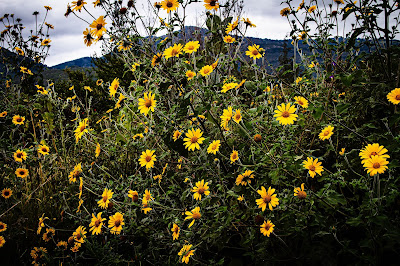San Miguel's special kind of autumn
Tuesday was the autumnal equinox, the official beginning of fall in the northern hemisphere or if you live in San Miguel, the peak of a colorful season that rather feels like spring, with cool temperatures and a cornucopia of wildflowers.
Up north, by Chicago, New York or Toronto, people eagerly await the leaves taking on their autumnal colors, and some newspapers will even publish maps of the best places to catch this glorious but ephemeral spectacle. But in truth it's a sad finale that signals nature slipping into hibernation, to hide from the grim rigors of the upcoming winter. Soon, around Thanksgiving, most trees will stand naked and spindly, and winter's gray will dominate the skies and the landscape.
After a very soggy rainy season that began in mid-May, the landscape around San Miguel is instead putting on the biggest and gaudiest display of flowers and greenery of the entire year. Bright-yellow flowers, three or four inches across, rise above their neighbors atop stems that reach six feet or more. The flowers must number in the hundreds of thousands, probably millions, if only someone could actually count them. On some stretches of the road to San Miguel, both sides are lined with these yellow marvels that inch right up to the edge of the pavement, as if ready to leap to the other side.
 |
| Hello, you beautiful yellow flowers |
I'm not certain of their proper name. They are way too big to be called yellow daisies or black-eyed Susans, but not quite big enough to rank as traditional sunflowers. Mexicans call them xotols, Stew calls them sunflowers. A handy pocket guide to the wild flowers of San Miguel, by Richard Cretcher, gives their botanical name as Tithonia tubiformis.
I prefer just "beautiful yellow flowers," and think of them as a last-minute farewell kiss by nature before our landscape also succumbs to the somber shades of San Miguel's own version of winter. Then the stately yellow flowers, along with fields of pinkish cosmos and dozens of other types of wildflowers, will quietly disappear, to be replaced, rather ominously, by cobwebs that will cling to the dead vegetation in the morning dew.

Comments
Post a Comment
Let us hear your opinions, thoughts and comments